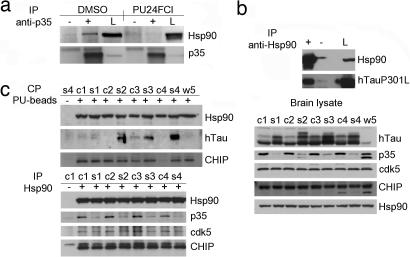Fig. 3.
mTau and p35 exist in a complex with Hsp90. (a) Immunoprecipitation (IP) of p35-containing protein complexes from COS-7 cells transfected with cDNAs corresponding to myc-His-tagged p35 with a control IgG (−) or a specific anti-p35 antibody (+) in the presence of vehicle or PU24FCl (10 μM). Lysate (L) was added as a control. (b) Immunoprecipitation of Hsp90-containing protein complexes from COS-7 cells transfected with cDNAs corresponding to TauP301L with a control IgG (−) or a specific anti-Hsp90 antibody (+). Lysate was added as a control. (c) Hsp90-containing protein complexes isolated through chemical precipitation (CP) with a solid support immobilized-PU (+) or control beads (−) (Upper Left) and through immunoprecipitation with a specific anti-Hsp90 antibody (+) or a control IgG (−) (Lower Left) from JNPL3 mouse brains. c1–c4 and s1–s4, cortical and subcortical brain homogenates, respectively, extracted from four 10-month-old female mice. w5 is whole-brain homogenate from a nontransgenic control mouse. (Right) Western blot analysis of brain lysate protein content. Hsp90 was used as protein quantification control. DMSO was used as a vehicle. CHIP, C terminus of heat-shock cognate 70-interacting protein.

